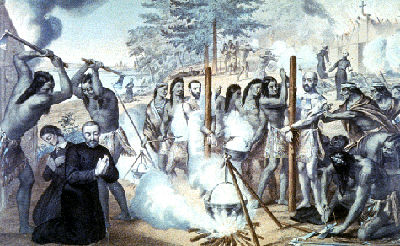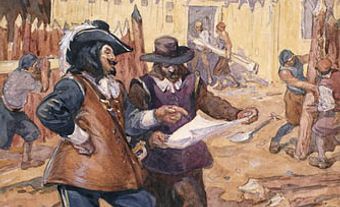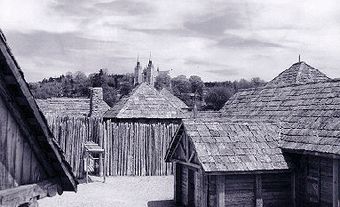The Jesuit Relations is a collection of the annual reports written by the Jesuit missionaries in Canada and sent to France from 1632 to 1672. These reports are an important historical resource regarding all of the events which occurred in the colony during this period. More specifically, they describe the central role played by the members of the Society of Jesus in the colonization of North America. (See Population Settlement of New France.) These reports provide an overview of the colonial vision of the times and describe the successes and failures of the missionaries in their efforts to convert the First Nations. Printed and distributed in Paris, primarily as a propaganda tool, the Jesuit Relations are very popular with travel literature enthusiasts. They remain a unique source of information regarding the early days of New France.

Difficult Beginnings in Canada
The Jesuit missions in North America took place during a period of transition regarding France’s colonial intentions, which were to convert the Indigenous Peoples living in distant lands. Through these initiatives, France was also seeking to expand its global influence and foster alliances and treaties. Interpreters, voyageurs, diplomats, preachers, the “Black Robes” (as they were called by the First Nations) quickly integrated into the communities that accepted them. The Jesuits very quickly became indispensable to the French administration and established themselves as gatekeepers between the colonial government and the Indigenous peoples.
In 1632, the Society of Jesus was granted a monopoly regarding the missions in New France, retaining this privilege until 1658. The circumstances were favourable for better control over the colony. During this period, everyday life experiences were recorded on paper and the reports were sent to Paris.
Voluminous Correspondence
From 1632, lengthy reports regarding every event that occurred in the colony were sent to France each year on the last ships to sail before winter. The missionaries from each mission produced the texts, which were subsequently reviewed by their superior in Quebec City, who added his own observations. Once they had been reviewed, modified, and even censored (if necessary), the Jesuit Relations were printed in Paris, almost a year after they had been written. They were used as a propaganda tool, highlighting the adventures of the missionaries in New France. Like the writings of Jacques Cartier and Samuel de Champlain, they were eagerly read by a French audience fascinated by the exotic nature of far-off lands. At the same time, these accounts were also intended to inspire both vocations and, above all, financial support.
The Jesuit Relations provide a wealth of details, containing entries regarding the weather, the languages, hunting techniques, and customs of the Indigenous Peoples, canoe trips, Indigenous diplomacy, food, etc. They laud the conversion of certain Indigenous chiefs to Catholicism, which made them loyal allies of the French Crown. A case in point is Jean-Baptiste Atironta, chief of the Huron village of Cahiagué (located near what is today known as Hawkestone, Ontario), the largest village of the Ahrendarrhonon (Rock) nation.
Wherever they established missions, the Jesuits described epidemics and conflicts that decimated the First Nations. Their lives were sometimes threatened by the Indigenous peoples, who accused them of witchcraft, of bringing disease, and of wanting to seize their lands. Some, in fact, were tortured to death (see Jean de Brébeuf).

Descriptive Bibliography and Literary Success
The Jesuit Relations consist of 41 volumes, which were reprinted many times. They are an impressive work, the product of contributions from many authors. Paul Le Jeune was the de facto architect of this work and himself wrote more than one-third of the Jesuit Relations. Other authors include Barthélemy Vimont, Jérôme Lalemant, Paul Ragueneau, François-Joseph Le Mercier, Jean de Quen, and Claude Dablon. The Jesuit Relations regarding the Huron missions were written by Jean de Brébeuf, François Le Mercier, Jérôme Lalemant, and Paul Ragueneau.
There were 53 “true” editions of these texts, not to mention the counterfeit and plagiarized editions (a testament to their obvious literary success). However, it was essentially a European success; the Jesuit Relations were barely read in North America before the mid-19th century. In 1858, Quebec City publisher/printer Augustin Côté undertook to consolidate all of the volumes into a new, comprehensive, three-volume edition. This monumental work was the result of the efforts of many people, for example, Abbot Laverdière who “with the patience and love of an antiquary” compiled an alphabetical table of contents regarding the subjects covered in the original work. This accomplishment will greatly facilitate any research which may be conducted by future generations.
Modern Criticisms
During the 20th century, new research raised doubts regarding certain accounts in the Jesuit Relations. Historians pointed out that the oral sources used by the Jesuits were not always assessed with the necessary rigour. In his book L’Amérique et le rêve exotique dans la littérature française au XVIIe et au XVIIIe siècle published in 1913, French historian Gilbert Chinard characterized the Jesuit Relations as “works of propaganda, rather than scientific reports.” He even asserted that ”it appears that the Jesuits travelled blind,” describing some things which better served their interests and objectives, at the expense of others.
The heroism of Adam Dollard des Ormeaux and his companions during the battle of Long Sault in 1660 is also the focus of a great deal of debate. The Jesuits gave him credit for having saved Montreal, writing that “everything would have been lost had they not perished, and their misfortune saved this country.” Historian Dollier de Casson made this story a national myth in his work entitled Histoire du Montréal, in which he depicts Dollard des Ormeaux’s sacrifice as an example of patriotism and bravery. This interpretation has been challenged by historians like Lionel Groulx, who published Dollard est-il un mythe? in 1960, and André Vachon, who signed the article regarding Dollard des Ormeaux in the Dictionary of Canadian Biography in 1966. Today, an informed reading of the Jesuit Relations must take into account the biases of the authors.
While the Jesuit Relations may have been criticized over the years, they remain an exceptional source of information regarding the early days of New France. With their colourful language, fascinating anecdotes, and vivid details, they paint a revealing portrait of the way in which history was written more than three hundred years ago.

 Share on Facebook
Share on Facebook Share on X
Share on X Share by Email
Share by Email Share on Google Classroom
Share on Google Classroom


